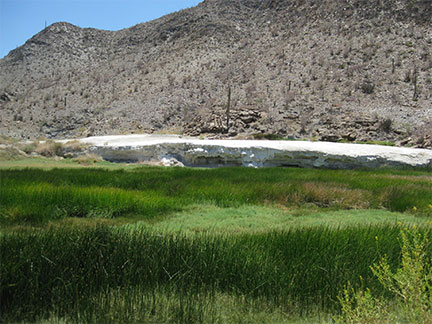 |  |
Jesuit mission site, gold ore mill, year-round desert stream
Article and photos by David Kier

Calamajué for some is hard to say, so try it this way: "cala-ma-way."
In 1746, Padre Fernando Consag explored the land north of San Ignacio to find new potential mission sites. Primary to a successful mission was abundant fresh water for growing crops as well as maintaining life. Not finding any place promising, he made another expedition in 1751 and again in 1753. Before the end of 1753, Consag found the year-round stream at Calamajué and although the water was heavily mineralized and made the Europeans sick, the Indians could drink it. There just was no other water in the region and when funds and new missionaries became available, Calamajué the only available choice.
On his expedition of 1766, Padre Wenceslao Linck made one large sweep of the peninsula north of his mission at San Borja. Springs of good water were found but abundant water for raising crops was desired. Linck found just such a place at Velicatá (the future site of Mission San Fernando, 1769) and the Jesuits made plans for a mission to be established there. However, the distance from San Borja to Velicatá was just too great.

In October of 1766, Padre Victoriano Arnés and Padre Juan Díez with 10 soldiers and 50 neophytes (Indians baptized at the San Borja mission) founded the 17th Jesuit California mission at Calamajué and named it Nuestra Señora de Columna (according to Padre Johann Jakob Baegert). Constructed was the chapel, storehouse, house for the padres and a house for the soldiers. Drinking water came from a well dug over a mile away and it was hoped that the mineral water from the stream would act as a fertilizer for the wheat they planted. Sadly, when irrigated with the stream water, it withered and died. There was no pasture for horses or other animals to graze at Calamajué either. The mission did prosper in attracting the areas Indians to be baptized who arrived in groups for conversion. Supplies could be brought up the gulf and offloaded at Puerto Calamajué about 20 miles down the arroyo from the mission.
Padre Díez became ill and was feared he would die. Thus, he had to be removed to San Borja, then on to Guadalupe to recover. Arnés continued his work at Calamajué until he learned from a neophyte of a better location 30 miles north. In May, 1767, Arnés moved the mission to the new location and even renamed it Santa María de los Angeles to reflect a fresh beginning.
Calamajué remained as a resting place on the mission road, El Camino Real until it became
the site of a gold ore mill in the early 1900's. The mill is across the arroyo from the mission
site and next to the automobile road, just before the road drops down into the arroyo. An
Englishman  named Dick Daggett and later Arturo Grosso of Rancho Laguna Chapala did
extensive prospecting and mining in this region.
named Dick Daggett and later Arturo Grosso of Rancho Laguna Chapala did
extensive prospecting and mining in this region.
Of the mission, only the melted adobe outlines of buildings remain. Some rock corrals are also there but may be from post-mission occupation. Ruins of the ore mill are more obvious and easily seen on the side of the cliff near the road or viewed from the mission site, across the arroyo.
Calamajué can be reached from Hwy. 5 at Coco's Corner by traveling east for 6.3 miles
towards Puerto Calamajué, then taking the right fork that heads straight south 7 miles
to the mill and mission sites. The mission access road is faint, but turns left once the road
is down in the arroyo, crosses to the far side and climbs a short grade to the site less than
½ mile away. The road that continues up the Calamajué creek is best driven in a 4WD. It
goes into a narrow canyon with beautiful geology, palm trees, and several water crossings
before leaving the canyon and arriving at a fork in 8 miles. To the right 5 miles is Hwy. 1 at
Km. 251. Ahead 7 miles is Hwy. 1 at  Km. 261 after passing Rancho El Crucero. This road
is sometimes used for the Baja 1000 off road race and can become quite challenging in the
Calamajué canyon after a race, or following any rains.
Km. 261 after passing Rancho El Crucero. This road
is sometimes used for the Baja 1000 off road race and can become quite challenging in the
Calamajué canyon after a race, or following any rains.

(Translated by Google) Hello, excellent fast service, I no longer waste time waiting anywhere...

We drove to Puerto Penasco MX., had an amazing time, great food and nice people, stay at Bella...

It was very easy to get, I applied on the internet I was approved within minutes and print it out...